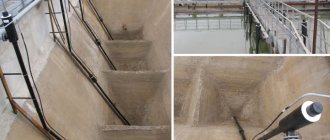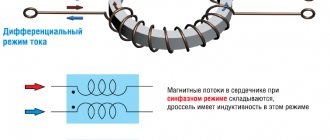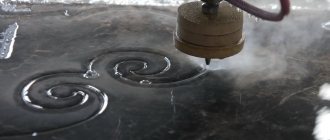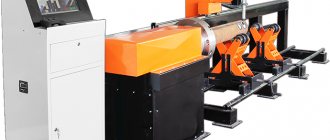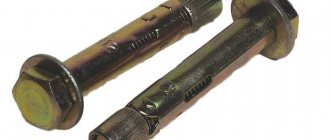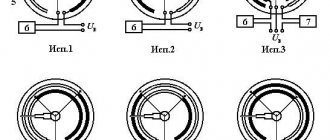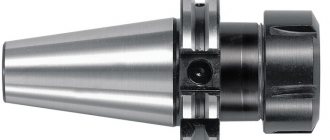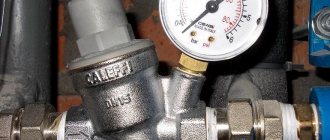There is a humorous saying: “A screw driven in with a hammer holds tighter than a nail driven in with a screwdriver.” Many home craftsmen have tried to combine the impact force of a hammer and the torque of a screwdriver.
This usually ended in tool failure. Finally, the impact screwdriver was invented, in which the impact force is correctly converted into torque.
Actually, the principle of operation of an impact screwdriver is similar to the operation of a bolt. The mechanic holds the handle in one hand and strikes the end with a hammer with the other.
There are two main types of power screwdrivers that work on the chisel principle:
Percussion. This is a modified bolt. Only the main purpose, not working as a jackhammer - but still loosening and tightening screws.
A distinctive feature of the tool is that the blade of the screwdriver runs across the entire length, from the working slots to the heel of the handle. Moreover, it is monolithic; no joints or welding joints are allowed. Of course, only high-quality alloy steel is used to manufacture such tools.
To realize the full potential of the screwdriver, the tip is shaped like a hexagon. There may also be a square or hex key on the heel of the handle. Of course - he is one with the sting.
How to use an impact screwdriver? For greater efficiency, it is better to work together. The splined part is installed on a screw that can be unscrewed (tightened), a key is put on the hexagon, and at the same time, frequent short blows are applied to the rear part with a twisting force.
An assistant should use the hammer, being careful not to hit the hand of the main worker.
Soured screws recoil due to vibration and are easily unscrewed. However, this type of screwdriver cannot provide a direct conversion of impact force into torque. Tapping the handle with a hammer only helps to unscrew or tighten a “heavy” screw.
Firstly, there is a specialized tool for these purposes, more durable and massive. In addition, a real bolt has hand protection in the form of a rubberized fungus. If the hammer comes off the heel of the impact driver handle, you can seriously injure your hand.
Popular: kitchen knife sharpening angle
Secondly, when using a screwdriver as an impact tool, it will very soon be hopelessly damaged. And the cost of such equipment is much higher than a simple bolt.
There is also a simpler version of the impact screwdriver, familiar to you from Soviet times. The monolithic body with two wooden plates ensures reliable transmission of force to large screws. If you couldn’t resist and used a screwdriver as a chisel, you can always restore the splines using a file.
Impact-rotary. This rather complex mechanical tool combines two power components: a blow to the end part, in addition to direct impact, is converted into torque.
The operating principle is similar to an impact drill. The spline part, with a sufficiently strong turning force, is affected by vibration from tapping with a hammer.
This saves time and health. The likelihood that you will hit your own fingers tends to zero. The impact rotary screwdriver mechanism is located inside the handle.
It is a gimlet with a small angle of twist relative to the axis. Rather, it is a gear with oblique teeth. It is acted upon by a ratchet clip.
When striking the heel of the handle, the cage moves forward, and the gear rotates in the direction selected by the switch.
As a result, two forces are transmitted to the working nozzle - rotating and translational. They act synchronously.
The advantage of the design is the effective use of impact force and the versatility of the tool. The advantages include less force with which hammer blows are applied.
The disadvantage is that the structure is not monolithic, so the effort must be measured. The mechanical part is subject to wear.
And of course – the price. Such devices are quite expensive (we are not talking about Chinese and Polish disposable fakes).
Tools in the set
A good set of reversible screwdrivers with removable bits includes the following items:
• Screwdriver (can be of several varieties, different sizes and with different types of handles)
• Bit holder (ordinary screwdriver, can be either with a straight or a T-shaped handle)
• Extensions (allow you to reach fasteners in deep holes or narrow, hard-to-reach places)
• Set of bits with slots for various fasteners
• Socket heads of different sizes, up to 13mm
• Adapters for socket heads
There are ratcheting screwdriver sets available for precision work.
They are easily recognized by the small size of the tools included.
An important element here is a flexible extension cord, without which it will be difficult to disassemble some connections in modern electronics.
How to make a small screwdriver quickly and efficiently
When you don’t have a screwdriver at hand, but have a bit from a screwdriver, you can make a screwdriver yourself. How to make it? In this article I will tell you and show you how to assemble an excellent screwdriver from scrap materials in a few minutes.
The big advantage of such a screwdriver is that without having a long handle, it can get into small or narrow places. It is with its compact shape that it is able to tighten any bolt.
When repairing a car, a problem often arises with unscrewing/twisting both bolts and screws into hard-to-reach places.
I took the bit from my screwdriver and decided to use it instead of a screwdriver. Unfortunately, she was unable to turn it. Fingers slip with any influence on it.
We make a screwdriver with our own hands from what we have!
Necessary elements for our homemade screwdriver:
- Bit - 2 pcs.;
- Large washers - 2 pcs.;
- Bolt with nut - 1 pc.
Assembling the screwdriver is the simplest. Let's get started!
You may have a question: “Why use 2 bits?”
I answer: “This is necessary for fastening. The washers will fit tightly both on the working bit and on the bit that will be in the form of an equalizer side. If we leave only one working bit, then after we tighten the bolt, the washers will adhere more strongly to the side in which there are no parts, and the opposite side will expand. And the kind of fastening we need will not be created.
The following steps should be followed:
Step 2: Glue the parts together
If you have a spare bit(s) and you don’t mind leaving it in this form, then you can fill our structure with glue or epoxy resin. Depending on what someone has at home.
Our little tool is completely ready for its intended purposes. And we ensured that our clubs did not slip. Relying on the ends of the washers, we have a large contact surface and can easily tighten the bolts and screws.
If stronger clamping (tightening) of bolts or screws is required, you can increase the lever of action by simply inserting a metal tool between the washers and tightening it stronger.
Source
Step-by-step production
Many craftsmen make a percussion unit with their own hands, and claim that this work does not require any exceptional knowledge or additional skills. You just need to follow the step-by-step instructions.
- First you need to take a rotor from any motor. Remove all present elements except the bushing and shaft.
- Place a piece of steel tube on the surface of the sleeve, which will eventually become a handle.
- A nut is inserted on the other side. It is this that helps prevent damage to the handle during physical impact.
7
- Next, the shank is sawed off, to which the bits are mounted.
- The last stage of work is to connect all the elements together by welding.
- The device is ready for use. It looks, of course, not as presentable as the factory models, but in terms of service life it can be much stronger.
If you follow all the steps correctly, you will get a makeshift impact screwdriver. As it turns out, making it is not as difficult as it might seem at the very beginning of the work. There is no need to use special drawings and markings. But if you have any doubts, it is better to contact a professional.
Rules for using the tool
An impact screwdriver is not an essential tool, so for many consumers the question of how to properly use the device to unscrew problem bolts is more than relevant. A user manual is included with the toolkit, if it is certified and belongs to the category of quality products from reliable manufacturers; however, inexpensive screwdrivers may not be supplied with such regulations. It is possible to figure out on your own how to use an impact screwdriver using the method of experiments and calculations, however, such tests can cause the tool to break if used incorrectly, or damage the working surface when trying to unscrew the hardware, which is also not always acceptable for the work performer. Operation of the product requires strict adherence to the manufacturer’s regulations, which will allow you to effectively cope with the task.
It is not difficult to use an impact-turning screwdriver in practice, since the tool has a vectorial purpose to reduce human effort when it is necessary to remove rusted screw hardware and make the unscrewing process as easy as possible.
To achieve the desired result, you should follow the following basic rules:
- Before proceeding with the actual removal of screw hardware, it is worth preparing the working surface. The process involves removing dirt and obvious rust from the surface of the hardware and the area around it.
- Treat the loose hardware with a chemical that helps remove rusty deposits. For this purpose, professionals recommend using WD-40 cleaner; however, kerosene, gasoline or brake fluid also does a good job.
- Next, you should start working directly with an impact screwdriver, having prepared the tool for use, and a regular hammer of medium size.
- When working with an impact screwdriver, you must begin by fixing its tip in the slotted head of the hardware, maintaining the perpendicularity of the position of the tool relative to the axis of rotation of the element being unscrewed.
- Strike the end part of the handle with a hammer. The impact force should be of medium intensity to avoid breakage or damage to the slot. At the same time, you need to monitor the hardware so as not to miss the moment when it starts to rotate.
- As soon as the screw moves from its dead point, put the tool down. Continue unscrewing the hardware using a standard type screwdriver.
When operating products equipped with a reverse motion, professionals advise adjusting the tightening mode of the fastener after the first shift of the screw head. The procedure will allow you to tighten the element after several light blows with a hammer, which will facilitate more effective removal of rust over the entire surface of the hardware. After this procedure, unscrewing the screw will be much easier.
When studying the regulations on how to operate an impact screwdriver, do not forget about safety precautions. It is necessary to work in protective gloves, in order to avoid the handle slipping in your hands, and do not make too intense blows, so as not to provoke the bit to slip off the screw head, which can result in injury to the worker.
Impact screwdriver bits
Kernel
Screwdriver shafts can vary in length, diameter, shape and strength. The strength characteristics of a rod are characterized by its hardness. According to GOST, it should be in the range of 47-52 HRC. If the hardness is lower, the rod may bend, if higher, it may crack. It is possible to ensure satisfactory hardness by using high-alloy chrome-vanadium steel, in which case “CR-V” or “chrome-vanadium” may be written on the rod. But such an inscription does not always guarantee quality, because it is not difficult for unscrupulous manufacturers to apply it. Conversely, famous manufacturers do not always write what, in their opinion, goes without saying. To ensure corrosion resistance, various protective coatings are sometimes applied to the rods. Sometimes the rods are covered with rubber or plastic, this makes the work of electricians easier, but it makes the rod thicker than the tip, so it is not always possible to reach the head of the fastener, which is deeply recessed into the part.
The length of the rod is usually 100-200 mm. For working in tight spaces, screwdrivers with a short shaft and a shortened handle are produced. If the fastener is located in a hard-to-reach place, it is more advisable to use a screwdriver with a long shaft and take a telescopic screwdriver with an adjustable extension of the shaft.
The diameter of the rod depends on the size of the tip and the loads for which the tool is designed. The cross-section of the rod can be not only round, but also hexagonal or square. This shape allows you to grip the rod with a wrench and provide more torque.
We must not forget that the rod must not only be durable, it must be securely fixed in the handle. This factor cannot be controlled visually, so unscrupulous manufacturers often pay insufficient attention to fixing the rod, and over time it begins to rotate. You can safely throw away such a screwdriver, because it will not be possible to revive it.
Sometimes the shaft of a screwdriver extends through the entire handle and ends at a heel that can be struck with a hammer. This screwdriver will come in handy if you need to unscrew a screw with a painted slot.
Design features
The simplest screwdriver consists of the following parts:
Lever
This part ensures convenient use.
Depending on where you plan to use the tool, the handle may have a pentagonal, hexagonal, round, square section, etc.
Another important parameter is its size.
For example, there are truly miniature screwdrivers, the handle size of which is so small that it is designed to be used with fingers rather than with the hand.
The materials used to make handles are usually rubber, plastic and wood.
Its shape, in addition to the usual cylindrical one, can be made in the shape of the letter “T” or “G”.
Kernel
Its length and thickness are selected in accordance with the depth and diameter of the hole in which the screw or screw is located.
A tip is a tip, the shape of which corresponds to the shape of the slot of the fastener.
The durability of a tool directly depends on the material from which its tip is made.
Parameters such as strength and hardness influence.
Initially, the shape of the working surface was something like a blade, which corresponded to the shape of the groove of the fastening element.
Over time, hex, Phillips, square and other splines have gained popularity, extending the service life of the tool.
Special screwdrivers allow for reliable installation of non-standard hardware.
An increased coefficient of friction is provided by a special coating that prevents the tip from jumping out of the groove of the fastener.
Impact screwdriver - how to use this “device” correctly and is it possible to make it yourself
Today, the Force impact screwdriver is very popular among builders—you can learn how to use it from the article. It is indispensable in cases where you need to unscrew a “welded” self-tapping screw or screw. An ordinary screwdriver is not intended for such “extreme” work, since its tip will quickly be damaged and it will become unusable.
What is an impact screwdriver? ↑
The video shows a cordless impact rotary screwdriver
In appearance, this instrument is not very similar to its ordinary “brother”. Its body is more durable and is made of metal, since it must withstand hammer blows without harm.
As a rule, this tool comes with two attachments - one for a Phillips screwdriver, and the other for a flat-head screwdriver. The connecting part into which these attachments are inserted has a square shape, which means that socket heads can also be secured in it, allowing you to work not only with screws and self-tapping screws, but also with bolts and nuts.
This is especially important for those who repair cars, where fasteners are known to often “stick” to parts. The screwdriver body is made with the addition of chrome vanadium alloy, giving it greater strength
The tool is sold both separately and with a large set of various accessories.
The screwdriver body is made with the addition of chrome vanadium alloy, which gives it greater strength. The tool is sold both separately and with a large set of various components.
The nozzles must be just as durable and not “collapse” after the first blow, so when purchasing, you need to pay attention to the metal from which they are made. The most durable attachments are made from an alloy of nickel, chromium and molybdenum
The most durable attachments are made from an alloy of nickel, chromium and molybdenum.
An impact rotating screwdriver can not only unscrew old fasteners, but also install new ones in their place. It also screws in “forever” - the fasteners fixed with it can only be dismantled with it.
Operating principle ↑
Cordless screwdriver - on video
First, let's look at the operating principle of this tool. When you hit the end with a hammer, the lower part of the tool and the attachment are rotated with a force sufficient for even the most firmly seated fastener to begin to rotate.
To simplify the work, rusty fasteners must first be wiped with a rag soaked in brake fluid. Then the screwdriver is installed on the head of the hardware (if possible, strictly perpendicular).
After this, you need to hit the end of the tool with a hammer. The success of the work here largely depends on how firmly the screwdriver is fixed in the hand.
When the fastener rotates around its axis a few degrees, you need to hit it with a hammer two or three more times and switch the screwdriver to the tightening mode and apply several blows again. This will help “shake off” rust from the fastener threads and make further unscrewing easier.
Once the fastener has moved out of place, it can be unscrewed with a regular screwdriver. If the hardware still does not want to give in, you need to moisten it again with brake fluid and wait about half an hour. After such a “bath”, even the most “harmful” fasteners should give in.
However, there may be exceptions - in this case you will simply have to break it out.
Selecting a hammer for working with an impact screwdriver should be based on the recommendations of the screwdriver manufacturer.
How to make an impact screwdriver with your own hands? ↑
You can make this useful tool yourself. To do this, you will need a rotor from any small electric motor, from which you need to cut everything off so that only the bushing and shaft remain.
A suitable piece of metal pipe is placed on the sleeve, which will serve as a handle. From the opposite end, a large nut is inserted into the piece of pipe, which will prevent the handle from breaking under the blow of a hammer.
Then all attached parts are welded together.
The end of the shaft must be sharpened into a square shape, just like a commercial screwdriver. A homemade instrument will turn out no worse.
In addition, the larger the rotor, the more powerful the screwdriver will be, which means that for successful work you will need to put in a little effort.
The force of the hammer hitting a homemade tool needs to be regulated, since with a powerful impact the slots on the fasteners can be torn off.
Step-by-step production
Many craftsmen make a percussion unit with their own hands, and claim that this work does not require any exceptional knowledge or additional skills. You just need to follow the step-by-step instructions.
- First you need to take a rotor from any motor. Remove all present elements except the bushing and shaft.
- Place a piece of steel tube on the surface of the sleeve, which will eventually become a handle.
- A nut is inserted on the other side. It is this that helps prevent damage to the handle during physical impact.
- Next, the shank is sawed off, to which the bits are mounted.
- The last stage of work is to connect all the elements together by welding.
- The device is ready for use. It looks, of course, not as presentable as the factory models, but in terms of service life it can be much stronger.
If you follow all the steps correctly, you will get a makeshift impact screwdriver. As it turns out, making it is not as difficult as it might seem at the very beginning of the work. There is no need to use special drawings and markings. But if you have any doubts, it is better to contact a professional.
Specifications
If you are going to purchase a screwdriver in a store, be prepared to understand the key technical characteristics and equipment of a particular model.
When reviewing these characteristics, it is not necessary to talk about the build quality and reliability of the material from which the tool is made. Trusted companies never use low-quality steel to produce such products.
You should pay attention to the presence of a reverse, which significantly expands the basic capabilities of the device, allowing you not only to unscrew rusty connections, but also to firmly tighten the screw in the place where it is needed. The next important factor is represented by the design of the handle, which is intended to hold the device and the body
If there is a polyurethane, rubber or polyethylene lining on the body, it is much more convenient to hold the screwdriver. If the pad has a “bulge” in the heel part, this has a positive effect on operational safety. In most cases, screwdriver manufacturers follow two paths:
The next important factor is represented by the design of the handle, which is intended to hold the device and the body. If there is a polyurethane, rubber or polyethylene lining on the body, it is much more convenient to hold the screwdriver. If the pad has a “bulge” in the heel part, this has a positive effect on operational safety. In most cases, screwdriver manufacturers follow two paths:
- The dimensions of the case do not change, while the screwdriver remains highly reliable, but cannot be used in extreme and cramped conditions.
- To expand the scope of application and improve ease of use, the dimensions of the metal case are reduced, although the reliability of the tool suffers because of this. When choosing the ideal solution, you should carefully weigh all the features and only then make a purchase.
It is no secret that popular brands produce screwdrivers along with an additional set of attachments, because without these elements the tool is simply ineffective. The screwdriver comes with a holder for standard bits, and the kit also includes several universal bits.
The market for such products is overflowing with attachments for various splines and hexagons. When purchasing these parts, be careful and consider the build quality. This is a very important parameter that determines the reliability of operation and service life of the screwdriver.
Marking
To ensure that a screwdriver fits a particular fastener, you need to pay attention to its markings.
In accordance with state standard requirements, it encodes not only the type of slot, but also the length of the rod and the number of the fastener.
For example, the marking РН3×150mm indicates that the tool has a cross slot (РН).
This slot is suitable for fasteners with a diameter corresponding to number 3 (5-7mm), and the length of the rod is 150mm.
Often the marking also contains information about the material from which the tool is made.
Thus, the abbreviation CrMo indicates that the working part is made of chromium-molybdenum alloy.
Distinctive feature
This model differs from an ordinary hand-held device only in its reinforced body, which is made of metal with an admixture of chrome vanadium alloy and is thick. It is several times larger than a traditional instrument. Thanks to the switching of torque, the product is called reversible.
Read also: DIY tipper lift
The screwdriver comes with 2 to 4 bits. They have a cross and a flat tip. The attachments are installed according to the same principle that is used when working with simple screwdrivers.
The most important distinguishing feature is the sting:
- it runs the entire length, starting from the slots and to the end of the handle;
- made from a single piece of metal;
- made of high quality steel.
When producing the tip, the use of joints and welding joints is unacceptable. This part of the screwdriver has the shape of a hexagon, and on the heel of the handle of the device there may be a square or hexagonal figure for a key.
When choosing nozzles, first of all you need to pay attention to what metal they are made of. The most durable alloys are: The manufacturer includes Russian-language instructions for the hand tool
The manufacturer includes Russian-language instructions for the hand tool.
The most popular manufacturers
Force brand products are used by both home craftsmen and experienced professionals. The most common model from this manufacturer is the Force 5064. This is a high-quality and very reliable tool that can easily withstand significant loads, which is why it is often used in service stations and in production.
Read also: Automatic machines for production
Another manufacturer that has already proven itself to be excellent is the Kraftool company. But its products are characterized by a rather high cost.
Polish tools from the Topex brand are perfect for household use, as they are affordable and of acceptable quality. The CrV steel alloy, which is particularly durable, protects the tool from mechanical damage, extending the service life of the product. The magnetic tip, which has undergone a hardening procedure, greatly facilitates the use of the breaker tool. This type of impact screwdriver is used mainly in everyday life, but they have also proven themselves in production.
Jonnesway brand products are considered the most versatile, so they are suitable for both industry and everyday use. Many note that this tool is characterized by an optimal ratio of quality and cost. The screwdriver is very durable and has excellent performance parameters. Professionals often choose this manufacturer, as it fully lives up to its price and expectations.
Impact screwdriver and small bits
ALEXEYASB
18-12-2012 13:12
Great big help. This is the situation. It is necessary to disassemble the IZH-43KN, the screws do not turn, I boiled it, poured WD-40, heated it but they do not turn and that’s it. I bought an impact screwdriver with 4 large bits, which I was able to unscrew, but there were still small screws that the large slot did not fit into.
The slot was reduced a little with a grinder, but there is no point in reducing it any further, in case larger ones appear later. So the question in general is this: I want to find an adapter from a large bit to a small one, or an adapter with 4-sided bits for small bits or small bits for an impact response. I visited all the stores in the area, there are only small bits or just impact screwdrivers in the stores, everyone shrugs, there is also some kind of silence on the Internet.
Can anyone give me a tip on where to look or maybe there are other devices?
bemi
18-12-2012 16:49
M.b., buy an L-shaped hexagon of the required number, cut off the straight part and grind one end to a standard square.
Adapters from a square to a small bit are everywhere.
Also, maybe it will help. It was possible to remove very tight screws with a screwdriver (with high torque).
It seems that with a hand with a good lever-knob the force is greater, but it doesn’t work. And Shurik - please. And it’s easier to hit with a shurik, you press on the bat exactly along the axis of rotation, the bit won’t slip. But drums are certainly better.
ALEXEYASB
12/19/2012 09:38quote:Originally posted by bemi: Adapters from a square to a small bit are everywhere.
Operating principle of an impact screwdriver
The simplest version of such a screwdriver is made in the form of a special tool with a monolithic core, which begins with a tip and ends with a massive heel in the handle area. This product was in demand back in the days of the Soviet Union.
Modern models are equipped with a hexagon near the tip or on the handle, so they are able to transmit rotational force from the key. To successfully complete the task, it is advisable to use a screwdriver together, since one worker will be able to hold the tip in the screw slot and create torque with a wrench, while the other will strike the back of the handle with a hammer.
True, such a solution has some disadvantages. Among them:
- The need for two partners to work together.
- Lack of conversion of received energy into torque. Hammer blows only unscrew a self-tapping screw or screw, since they are capable of destroying rust and creating a certain vibration. The version of the impact-rotary screwdriver is more advanced, so it can transform the impact force into a rotational movement of the tip, which is very convenient.
In most cases, the term “impact screwdriver” means precisely a modernized solution, since the classic simplest version has long gone out of common use and has ceased to enjoy its former popularity.
In the improved version, the impact-rotating unit is located in the handle, and the sting is fixed on the gear and has characteristic oblique teeth. A clip with counter teeth is used as a handle. Under the influence of hammer blows on the heel of the handle, the clip begins to move along the axis, imparting a rotational movement to the tip through a gear drive.
In this way, a rotation of several degrees occurs, which is quite enough to loosen the protective connection and successfully unscrew the fastener using a conventional tool. As a result, the clip returns to its previous position by means of a spring.
Operating such a screwdriver is not difficult at all. The rotary mechanism is capable of providing a combined translational and rotational force on the screw slot, which is very effective for successfully unscrewing stubborn threaded connections.
